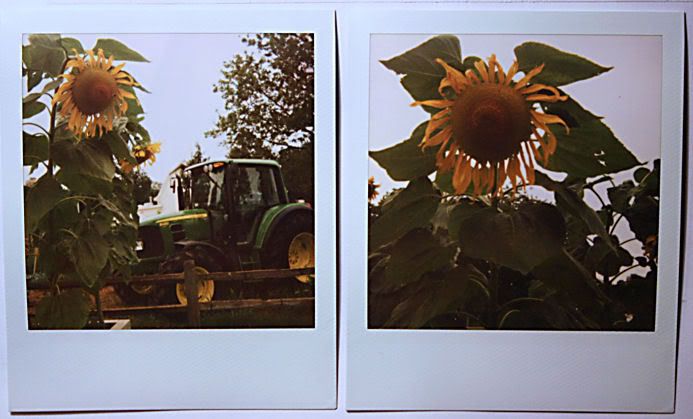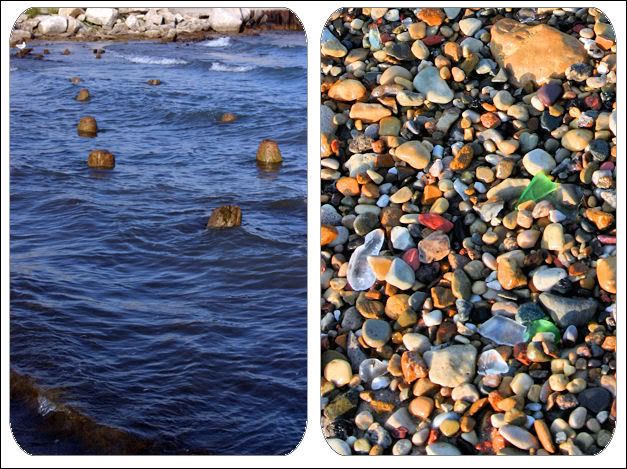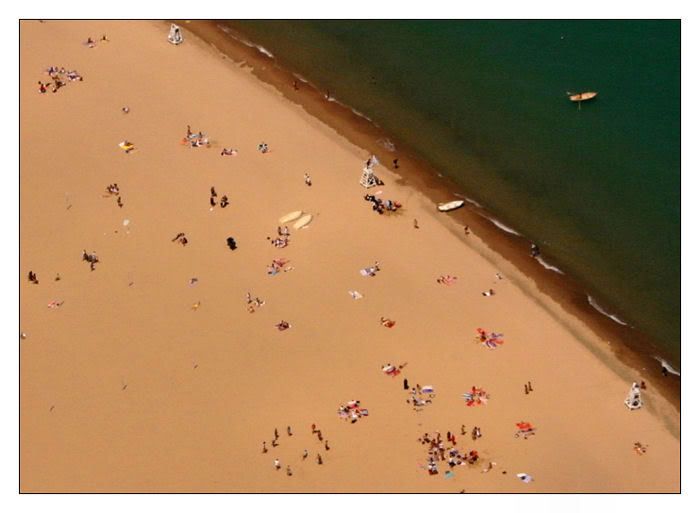
(Photo I took of an urban window in LA-- that's a potted Bird of Paradise)
The majority of Americans do not live in rural areas, working everyday with the land; instead we live in the mainly manmade constructed environments of the suburbs and cities. Even though modern civilization has been removed from a hunting/gathering society more integrated with nature, we still crave a connection to the natural world. In the suburbs, many pride themselves on a lush, perfectly manicured lawn, while those in the city maintain herb gardens and potted plants and hope for ‘views’ from their windows, especially that of a lake or an ocean. In the public realm we build elaborate natural history museums, aquariums, botanical gardens and parks. Right in the middle of the bustling streets of NYC you can find a pond, acres of trees and geese, all engineered and placed by people, rather than nature, at the turn of the century.

Polaroid photographs I took of 'farm life' in Chicago-- this is an exhibit at the Lincoln Park Zoo.
So if we’ve adapted to a suburban or city lifestyle, why do we still yearn for this contact with nature? In their book, “The Biophilia Hypothesis,” Stephen Kellert and Edward Wilson examine the biological basis for biophilia or “the innately emotional affiliation of human beings to other living organisms. “ Kellert and Wilson postulate that there is actually an “innate” reason for why we seek out flora and fauna, that we’re genetically predisposed to look to nature not only for sustenance but for its aesthetic beauty and even for our own emotional fulfillment.

(Two scenes of a small strip of beach near the Museum Campus in the South Loop. I was drawn to what has become the integration of manmade materials and nature-- the weathered posts of a now-flooded dock and the bits of broken bottles now weathered and smooth by the tumbling of the lake)
While I’ve generally been aware of the concept behind biophilia, this is the first time I knew its proper name. It has played a role in my own life, especially evident when looking back on how my relationship to nature has changed due to my geographical location. During my childhood spent in Hawa’ii, a culture more integrated with the wilderness, I did not have to go far to directly experience the Pacific Ocean, tropical rain forest or a (dormant) volcano—they were either literally a few steps from my home or a 15-minute drive away. As a teenager in Arkansas, however, I lived in “the natural state” but experienced only my backyard and city parks on a regular basis. This is the time I began to make regular trips to Lake Fayetteville, a small manmade lake a short drive for my home, to walk the trails, read and generally experience a more “transcendental” view of nature, ie finding inspiration by being out there by the water. Now that I’ve lived in a city for almost six years (first LA now Chicago), I find myself raising potted plants in my kitchen windowsill and stopping by the farmer’s market for fresh flowers in the summer. While we’re landlocked here in Illinois, I still find myself drawn to water, the shores of Lake Michigan, for relaxation and escape from the sticky summer streets.

(My view of Lake Michigan from the 95th floor of the John Hancock building. It's surprising how abstract the people become at this distance)
Even though I’ve chosen to live in an urban environment, I’m still compelled to include nature in my life—is this due to a learned behavior (growing up on an island surrounded by water) or has it been hard-wired into me, and the rest of humans, to continue this relationship with nature? Kellert and Wilson would say that these tendencies are a result of a genetic advantage, that the brain evolved in a biocentric world and we have not evolved quickly enough in this now machine-regulated world to erase those preferences and behaviors. Wilson argues that biophila evolved by the means of biocultural evolution, that natural selection occurred in a cultural context. His theory of gene-culture coevolution seems to address the issues of both nature and nurture though I still question the ability of science to measure something as abstract as emotional fulfillment or “the human spirit” via the use of biological data.

(The trails at Lake Fayetteville are all paved which is fitting as it's a manmade lake)
What is the importance of the study of biophilia to us and the scientific community? Wilson cautions that since the natural environment is fast disappearing, we should ask what “will happen to the human psyche when such a defining part of the human evolutionary experience is diminished or erased?” He believes that “humanity will be poorer for all generations to come” with the loss of biodiversity. Thus we find out that Wilson is pushing a conservation agenda using an evolutionary theory as his basis. He ends his article with affirmations such as “other species are our kin” and “biodiversity is the frontier of the future,” and argues that humanity will not find fulfillment for our “spiritual craving” in space, but right here at home.
While I admire Wilson and Kellert for trying to understand our propensity for nature in biological terms, I question to what ends they are putting their findings. While biodiversity is obviously important for the world’s ecosystems, we need to develop a more practical conservation ethic, one that operates not only in theory but in practice. Most of us recognize that the tropical rain forests are shrinking rapidly (remember children’s movie Fern Gulley?), that we need to save the whales and that global warming is a reality. So what is the solution? Wilson and Kellert promote an awareness of our genetic connection to nature, hoping this will affect the way we view conservation. Kellert also argues that while Americans have a strong appreciation of nature, we only value more visible elements like mountain ranges or large mammals rather than taking a more ecological view. What’s frustrating about the conservation aspect of biophilia is that it remained largely conceptual within the articles, thus making if feel dated, if conservation was really the agenda of Wilson and Kellert, I urge a discussion of practical application (which I believe we are beginning to do in this more eco-conscious age that has even the largest corporations thinking ‘green’).


Recently I came across the interior landscape firm, Planterra, whose motto is "The tranquility of nature can provide us peace in our caverns of concrete and steel." They seem to represent one aspect of the biophilia tendency, bringing nature back into our lives. Being a commercial firm, however, I feel they overly romanticize the aesthetic experience and divorce nature from any sort of context. This is especially evident in their offering of replica foilage, an eco-friendly improvement on yesteryears' tacky plastic plants: "A preserved palm is made from organic tree material that is treated and expertly attached to a structural core of fiberglass. Everything seen and touched is from living trees. The material is harvested with annual pruning and grooming -- all without cutting down the tree or harming the environment. While I admire their efforts, some of their examples appear outright absurd (reference the photo of the 'living wall' with the flatscreen TV).


Another approach of re-introducing nature into our urban lives comes via a group of environmental artists who specialize in "green grafitti." Instead of using toxic spray paint to deface buildings, they instead cultivate growing plants to spell out their messages and create their illustrations on brick walls, concrete pillars and warehouse ceilings.
London-based artist Anna Garforth used moss to spell out the first verse of a poem on a brick wall, she is currently working on growing verses of the rest of the poem in various locations throughout the city.


Hungarian moss artist Edina Tokodi creates her moss art in the streets of NYC, best known for her rabbits and other animals, she has branched out to represent man-made objects.


Spanish artist Patrick Blanc went big and covered the side of Caixa Madrid in moss and grass, creating a vertical garden.

I leave you with this, a living bath mat that feeds off you and your bath water. The mat was created by Switzerland-based industrial designer La Chanh Nguyen and features three three types of live green mosses - ball moss, island moss and forest moss - that grow in individual “cells” of plastazote, a decay-free foam. It also requires little maintenance because mosses thrive in humid areas like bathrooms.



Have you seen Kellert's other, more recent book? Biophilic Design: The Theory, Science, and Practice of Bringing Buildings to Life. It's all about making buildings more responsive to the idea of biophilia (more light, trees, semblance to natural pathways, etc...).
ReplyDelete